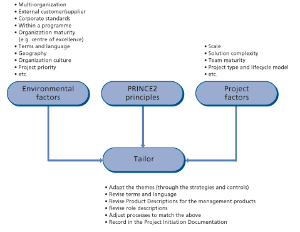PRINCE2 2009 - Directing Projects with PRINCE2 part 77
of the Cabinet Office under delegated authority from the Controller of HMSO.
Tailoring PRINCE2
What does tailoring involve?
This section considers how each element may or may not be tailored and proposes a logical generic approach.
PrinciplesThe PRINCE2® principles should always be applied.
The manner in which they are applied may vary but, if any principle is removed, the project is no longer complying with PRINCE2.
The value of the principles in tailoring is as a check - are we still applying all the principles?
Adapting a theme does not necessarily mean modifying the method.
In most cases, the environmental and project factors are incorporated into the project’s strategies and controls.
Relevant corporate or programme policies and standards are captured and documented in the project’s Risk Management [see ‘The Complete Risk Management package’] Strategy, Quality Management Strategy, Configuration Management Strategy and Communication Management Strategy.
These management products will describe the procedures to be used on the project that fulfil the requirements of the corporate or programme organization.
The level of control required will influence the formality and frequency of reviewing and reporting.
All the PRINCE2 process activities need to be done; it is just that the responsibilities for performing the activities may change (if roles have been adapted) and references to the management products may need to change (if any management products have been adapted).
EnvironmentTailoring the external environment of the project is more generally addressed in embedding, i.e. the process of implementing PRINCE2 across an organization, rather than for an individual project.
Nevertheless, where there is large-scale project work, there may be some measures that can be taken in the host environment.
For example:
- Finance/budget provisions: projects very often span organizations’ financial years and may well be disrupted if they are conducted in the context of an annual budget cycle. Large projects are usually better considered as capital investments
- ‘Recognition’ of projects: organizations are typically managed as ‘line structures’ responsible for permanent functions, finance, procurement, production, customer services etc. Projects are temporary, cross-functional organizations - consequently they tend to receive less recognition in corporate processes and decision making. The more that projects and/or business change becomes important to corporate objectives, the more recognition should be accorded to the temporary programme and project structures. Some organizations are fully ‘projectized’, i.e. projects/programmes become the main context for decision making and line functions simply provide resources and administrative/quality services to the various categories of personnel engaged on project work
With these considerations in mind, a logical approach to tailoring is illustrated in the diagram.
All references above are in Directing Successful Projects with PRINCE2 unless stated otherwise.
PRINCE2® is a Registered Trade Mark of the Office of Government Commerce in the United Kingdom and other countries.
Managing Successful Projects with PRINCE2 - 2005 edition
Managing successful Projects with PRINCE2 – 2009 edition
Directing Projects with PRINCE2.
plus:
The Complete Project Management package.
And much more besides - at a fantastic price.



